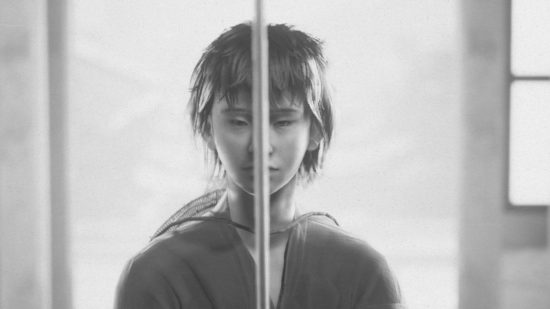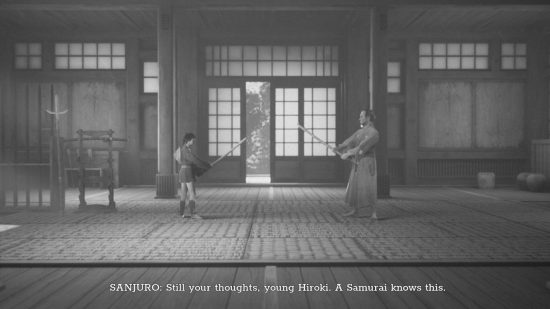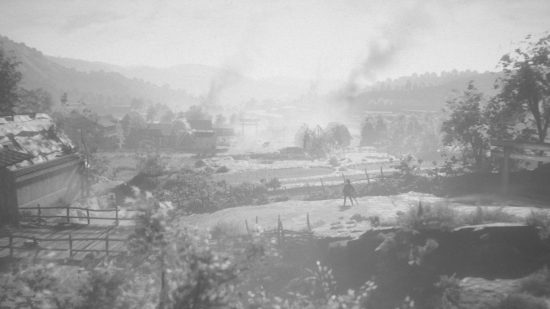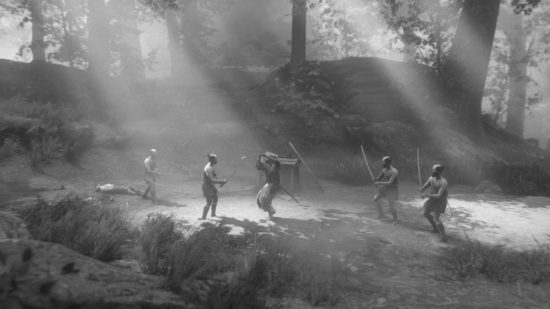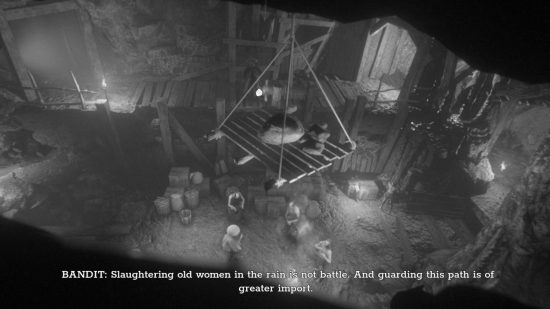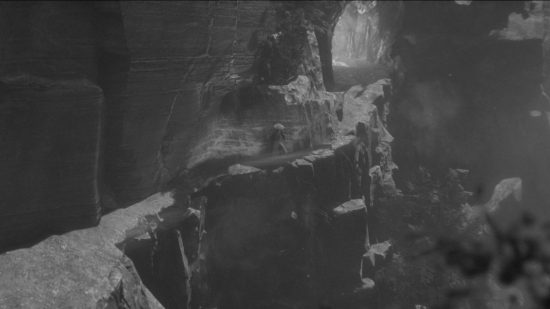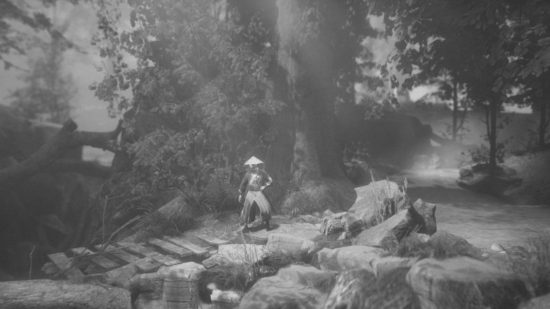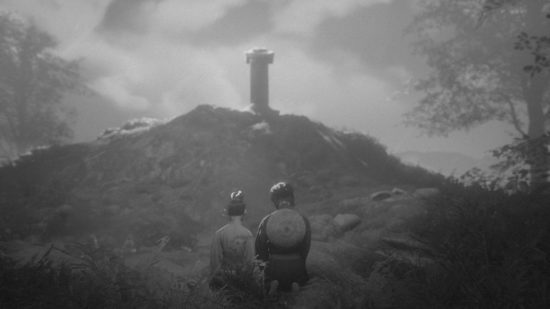A trek is defined as a long and arduous journey, and Trek to Yomi certainly lives up to its name. It is, indeed, a long journey, portraying a classic tale of honour, love, and, above all, revenge – all told through cinematic camera angles, excellent voice acting, and the lens of a traditional Samurai movie. The gameplay comes secondary to its aesthetics, and, as a fan of Samurai flicks, there’s a lot here for me to love.
Unfortunately, it also lives up to the arduous part. The tedium of its conveyor belt full of samey enemies wears on you over time, and the novelty of the aesthetics may well not be enough to keep many of you engaged throughout its entire runtime. This is especially true of the Trek to Yomi Switch version.
Naturally, with the Switch’s ageing hardware and undeniable restrictions, many games ported to the console struggle to keep up with other platforms in terms of graphics. While that usually doesn’t bother me, in a game so heavily reliant on its aesthetics and visual design, the graphical issues are more apparent here than in many other titles I’ve played.
Please note that you are also prevented from screenshotting Trek to Yomi on Switch. I’m not sure if this is due to RAM preservation or something else, but, as such, all images in this review are taken from the PC version, and don’t accurately reflect how the game looks on Switch.
So let’s start from the first leg of the journey. Trek to Yomi is a love letter to old Japanese cinema – specifically, Samurai flicks – and it captures that essence particularly well. It begins with you taking control of a boy called Hiroki, who loses his master Sanjuro during a siege on his hometown. On his knees, he vows to his dying Sanjuro that he will protect their people and the ones he loves from the ever-looming threat.
Leaping through time, Hiroki is now an adult and a fully-fledged lone Samurai, dedicated to protecting his hometown alongside his childhood friend Aiko, who also happens to be his late master’s daughter and Hiroki’s sole love interest.
After the enemy returns to ravage the land in another catastrophic raid, Hiroki arrives at his village to find many of his people slain at the hands of merciless bandits. He soon faces off against the same monster who killed his master when he was a child, but the tides of battle are not in his favour. From this point, he begins his true trek through ‘Yomi’ – in translation, the underworld.
The narrative is solid, if not a bit cliche. You won’t find any genre-changing twists here, but I honestly don’t mind that. I adore old Samurai films, and this somewhat formulaic tale emulates their style very well, while still having enough emotion to set it apart from the stories it draws upon.
Trek to Yomi’s experience is dramatically enhanced by its excellent sound design, including brilliant sound effects, stunning music, and top-notch Japanese voice acting. There is also an English dub that you can switch to through the settings, but I’ve not tried it myself. I highly recommend playing with noise-cancelling surround sound headphones, as the layered audio is truly immersive and highly detailed, from the cries of the injured to the crackling of fire, and even the threatening chuckles of your bloodthirsty enemies.
The gameplay predominantly relies on side-scrolling exploration and combat, with some minor puzzles and collectables to flesh it out. Combat is somewhat clunky, though I found myself adjusting to it pretty quickly. There are quite a few combos to master, but as long as you get to grips with when to block, parry, and counter-attack, you can get through most fights on easy and medium difficulty with little to no issues.
Due to its side-scrolling formula and the involvement of directional commands in attacks, you have a button dedicated to switching directions in combat. Combine this with the fixed camera angles, and the game begins to feel reminiscent of old PlayStation-esque tank controls (think old-school Resident Evil). However, with some practice and a hefty amount of blocking, flicking side to side to take down enemies quickly becomes second nature.
Combat is further enhanced by the addition of projectiles – collectable bo-shurikens and a bow and arrow. These attacks are powerful and allow you to take down enemies from a range, but your max carrying capacity for the ammunition is pretty limited, especially in the early game. This adds a nice layer of depth to battles, encouraging you to be economical with your ranged attacks and scour the map for replacement ammunition.
Hiroki also has a stamina metre for you to consider. Outside of combat, you can consistently sprint without tiring, but in combat, your stamina management becomes more of a limitation to adapt to. Blocking attacks, dodge rolling, sprinting, and dishing out heavy attacks drains your stamina. It replenishes quickly but, if an enemy knocks you back and leaves you staggered or exhausted, you’re momentarily left open to incoming attacks. While stamina drainage can be frustrating in many games, I feel it’s well implemented here and encourages mindfulness rather than over-reliance on button-smashing combos.
The main issue with Trek to Yomi’s combat is the severe lack of enemy variation. While the battles themselves can be quite challenging on harder difficulty levels, throughout your journey, you find yourself facing the same handful of bandit models you’ve been cutting through since Hiroki’s literal childhood. Even in the underworld, rather than slashing down beastly monsters, you find yourself on the same conveyor belt of samey dudes that seems to never end.
Luckily, the bosses offer a nice change of pace now and then, with more varied designs and unique attack patterns and combo breaks. However, your tactic remains the same for the most part – block, parry, counter–attack, and hope for the best.
As I mentioned above, the different difficulty settings do make a difference to your overall experience, though this is predominantly an artificial change that simply increases enemy HP and how much damage they deal. However, this does push you to use your combos more mindfully and ensure you pay attention to your stamina as you dodge and block a tirade of attacks. If you find yourself unhappy with your current difficulty setting, you can change it at any time through the options menu, though this does cause you to reload from the last save spot.
Outside of combat, you have single-use shrines dotted along your path that both save your game and replenish your stamina and health. These are relatively close together and I rarely find myself struggling to get from one shrine to another. Then, beyond the occasional bo-shuriken or arrow for you to grab, there are also collectables that sometimes increase your stamina or health, teach you a new combo, or simply reveal a bit of the world’s lore.
There are also environmental elements that you can interact with, such as trees that you can push over to get across ravines, bridges that you can sabotage to send a group of enemies plummeting to their deaths, or doors that you can kick down to access secret rooms. You occasionally have the opportunity to rescue villagers, usually in said secret rooms, who chat with you and sometimes give you items as thanks, all adding to the overall worldbuilding and padding the experience out nicely. However, beyond these occasional deviations, the game remains predominantly linear.
Now, let’s get onto the main focus of Trek to Yomi – its visuals. The game is entirely black and white, overlaid with a noise filter and lens bloom to make it feel like an old movie. As mentioned above, the fixed camera angles are very cinematic, sometimes showing the action through silk screens, from the hull of a boat in the distance, or panning across a landscape.
This creative use of viewpoints does much to enhance the aesthetics of the game, framing it in a set way as though you truly are controlling a character in a movie. The main drawback of this is that sometimes the paths are hard to decipher, and certain scenes zoom out to the point where your character is extremely small. This is most problematic when playing in handheld mode, especially when you suddenly find yourself attempting to fight a group of enemies from such a distance that Hireko appears no larger than a centimetre.
In its striving to appear more cinematic, Trek to Yomi also strips back the UI to a minimum. Yes, you get occasional tutorials popping up in the corner now and then, but beyond those and your stamina/health bar during combat, there’s no on-screen clutter to hint towards this being a videogame. Similarly, the cutscenes blend with the gameplay very well, and even the initial tutorial is implemented in such a way that it genuinely feels like a sparring lesson between Hiroki and his master.
This level of immersion and blending between cinematics and gameplay is where Trek to Yomi truly shines and sets itself apart from other games. However, it’s also where the Switch version fumbles the most. As I highlighted at the start of this review, it’s clear that the Nintendo Switch struggles with the highly detailed environments in the game. It frequently suffers from texture popping, artifacting, visible foliage culling, flickering shadow and light effects, and all the other usual offenders.
Playing the game on handheld especially sees the quality drop, even with an OLED screen – the lens bloom and noise filter does little to disguise its rough edges, and instead acts as more of a hindrance, making certain scenes with intense lighting appear blurry and hard to make out. I know it’s quite an unfair comparison, but having tried Trek to Yomi on PC through the Xbox Game Pass and seeing how it’s supposed to look, it’s sad to see it struggle so badly on the Switch.
On the plus side, the Switch controls for Trek to Yomi are intuitive, comfortable, and responsive. Throughout my playtime, I suffered no lag or stuttering, and it’s a pretty fluid experience overall. Load screens are quite long, but are very few and far between, and the option of portability is very appealing for such a movie-like game.
It takes around five hours to complete the main content, or a little longer if you strive to grab all the collectibles. This may sound short, but I feel it’s the perfect length for this movie-like tale, and prevents it from overstaying its welcome. Its length also makes it a great virtual journey to embark on while taking a real-world journey, especially if you’re looking for something a little more hands-on than your standard on-flight movie.
Overall, I’m quite fond of Trek to Yomi, and appreciate its ambition and uniqueness. Though it can be quite the trek to get through, its unique aesthetic, artful emulation of classic Samurai flicks, and relatively simple narrative make for an enjoyable experience that I highly recommend to anyone with a passion for the films it parallels.
However, with its main focus being on aesthetics, I don’t feel that the Switch, for all its restrictions, is the best place to play it – especially as it’s currently available as one of the many Xbox Game Pass games at no extra cost, or on other platforms for the same price as the Switch version. But, if you’re jonesing for a good old Samurai revenge flick on the go and are willing to overlook the graphical shortcomings, then feel free to unsheath your sword and prepare to tread the path of the lone samurai – to Yomi we go.
If this whet your appetite for some old-school action, be sure to check out our list of the best Samurai games and the best ninja games on Switch and mobile. Or, if you’re looking for something a bit more metal, head over to our list of the best knight games.
Trek to Yomi Switch review
Trek to Yomi is an ambitious journey revolving around love, honour, and, above all, revenge. An ode to classic Samurai flicks, its gameplay is simple, but its striking aesthetics and clear focus on cinematography is what truly sets it apart – unfortunately, it’s also where it struggles the most due to the performance limitations of the Nintendo Switch.
